含取代基苯基羧酸与柔性含氮配体构筑的三个过渡配位化合物的合成、晶体结构与物理性质
2016-12-15吴小说汪鹏飞路朋朋徐思源
吴小说 汪鹏飞 路朋朋 徐思源
含取代基苯基羧酸与柔性含氮配体构筑的三个过渡配位化合物的合成、晶体结构与物理性质
吴小说 汪鹏飞*路朋朋 徐思源
(池州学院化学与材料工程学院,池州247000)
利用3,5-二硝基苯甲酸(3,5-DNBH),1,2-双咪唑亚甲苯(1,2-bimb)与3种过渡金属盐通过水热反应成功地构筑3个过渡金属配位化合物,即[M(3,5-DNB)2(1,2-bimb)](M=Co(Ⅱ)(1),Cd(Ⅱ)(3))和[Zn(3,5-DNB)2(1,2-bimb)]n(2)。通过红外光谱、元素分析、单晶和粉末X射线衍射表征了这三个化合物。化合物1和3是同构的,含有一个双核单元[M2(COO)2],该双核单元由金属离子、3,5-二硝基苯甲酸根以及1,2-bimb分子构成。双核单元再通过O…π弱相互作用形成超分子结构,该弱相互作用是通过3,5-二硝基苯甲酸根上的硝基氧原子与1,2-bimb上的苯环所形成。化合物2是一维链结构,链与链之间再通过3,5-二硝基苯甲酸根和1,2-双咪唑亚甲苯配体上苯环之间的π…π相互作用,形成了一个超分子结构。室温条件下研究了化合物2和3分散在甲醇中的荧光性质。热重测试结果显示3个化合物具有相对较高的热稳定性。可见光照射条件下化合物1对罗丹明B具有一定的催化降解能力。此外,直流磁化率结果显示化合物1中金属离子之间存在反铁磁相互作用。
过渡金属配合物;磁性;光催化性能
0 Introduction
Over the last few years,coordination complexes have attracted much attention not only because of their fascinating topological structures but also due to their potential applications in many fields,such as gas storage/separation,catalysis,luminescence,ionexchange,and magnetism[1-6].But they are less investigated for pollutant organic dyes adsorption and removal[7-9].Recently,a particularly interesting and challenging research in the coordination chemistry is the design and synthesis ofphotocatalytic coordination complexes due to their high thermal and chemical stabilities[10-13].On the other hand,coordination complexes could involve various kinds of charge transfer between metal ions and organic linkers,which enable coordination complexes to exhibit adsorption band in the visible region.Thus,coordination complexes may undergo photochemical process under visible light irradiation and be good candidate for photocatalytic materials[14-16].Compared with the commonly employed many coordination complexes,however,limited works focused on the development of such new coordination complexes as photocatalytic materials have been reported.3,5-dinitrobenzoic acid(3,5-DNBH)is a multifunctional ligand containing two kind of coordination modes,concluding neutral(3,5-DNBH) and in the anionic form(3,5-DNB-)[17-20].In this work, three transition metal complexes,namely,[M(3,5-DNB)2(1,2-bimb)][M=Co(Ⅱ)(1),Cd(Ⅱ)(3)]and[Zn(3,5-DNB)2(1,2-bimb)]n(2)have been obtained through using the flexible bis(imidazole)ligand(1,2-bimb)and 3,5-dinitrobenzoic acid(3,5-DNBH)in the presence of transition metal salts.Complexes 1 and 3 are isostructuralcontaining a dinuclear[M2(COO)2](M=Co(Ⅱ)(1), Cd(Ⅱ)(3))unit,and complex 2 features a 1D chain structure,which further packs to the supramolecular structure by theπ…πinteractions between the benzene rings from 1,2-bimb molecules and 3,5-DNB anions.Notably,complex 1 shows good degradation ability over rhodamine B(RhB)under visible light irradiation.The fluorescence properties of 2 and 3 have been investigated in their dispersion methanol solution state at room temperature.In addition,the magnetic properties of 1 have also been studied in detail.
1 Experimental
1.1 Materials and methods
The flexible bis(imidazole)ligand(1,2-bimb)was synthesized according to a previous report[21].Allother chemicals were obtained from commercialsources and used without further purification.C,H,and N elemental analyses were performed on a PerkinElmer 240C elemental analyzer.The infrared spectra(KBr pellets)were recorded on a Nicolet iS10 spectrometer in the range of 500~4 000 cm-1.Powder XRD data were collected on a Rigaku UltimaⅣX-ray diffractometer with Cu Kαradiation(λ=0.154 056 nm)over the 2θrange of5°~50°at room temperature.The XRD accelerating voltage and emission current were 30 kV and 50 mA,respectively.Thermogravimetric analyses (TGA)were performed on a Perkin-Elmer Pyris 1 TGA instrumentin the range of30~800℃under a nitrogen flow at a heating rate of 20℃·min-1.Fluorescence spectra of the dispersion methanol solution of complexes 2 and 3 were recorded using a Shimadzu RF-5301PC spectrofluorometer at room temperature.The solid-state diffuse-reflectance UV-Vis spectra for powder samples were recorded on a Shimadzu UV-3700 equipped with an integrating sphere by using BaSO4as a white standard.The UV-Vis spectra for solution samples were obtained on a Hitachi UV-3900 spectrometer.The dc magnetic susceptibility data of 1 were measured on polycrystalline sample using a Quantum Design MPMS-XL-7 SQUID magnetometer.
1.2 Syntheses of complexes 1~3
1.2.1 Synthesis of[Co(3,5-DNB)2(1,2-bimb)](1)
A mixture containing Co(NO3)2·6H2O(0.029 1 g, 0.1 mmol),3,5-dinitrobenzoic acid(3,5-DNBH)(0.042 g,0.2 mmol),1,2-bimb(0.023 8 g,0.1 mmol)and NaOH(0.004 0 g,0.1 mmol)in 10 mL deionized water was stirred at room temperature for 30 min.Then the mixture was transferred to a Teflon-lined autoclave and heated at 140℃for 72 h.After cooling to room temperature,purple block-like crystals were collected by filtration and washed with deionized water and ethanol several times with a yield of 45%based on Co.Anal.Calcd.for C28H20CoN8O12(%):C,46.74;H, 2.80;N,15.58.Found(%):C,46.58;H,2.87;N,15.61. IR(KBr,cm-1):3 447(m),3 113(m),1 646(s),1 612 (s),1 574(m),1 541(s),1 470(m),1 398(m),1 348 (s),1 303(w),1 234(w),1 112(w),1 087(w),1 074 (w),1 030(w),945(w),925(w),824(w),793(w),752 (w),729(s),660(m),620(w).
1.2.2 Synthesis of[Zn(3,5-DNB)2(1,2-bimb)]n(2)
Complex 2 was prepared following a similar synthetic method except that Zn(NO3)2·6H2O(0.029 7 g,0.1 mmol)was used as the metal sources.Colorless block-like crystals of2 were collected as a pure phase. Yield:40%based on Zn.Anal.Calcd.for C28H20N8O12Zn(%):C,46.33;H,2.78;N,15.44.Found(%):C, 46.46;H,2.85;N,15.31.IR(KBr,cm-1):3 438(m), 3 127(w),3 092(m),1 637(s),1 589(w),1 536(s), 1 457(m),1 348(s),1 291(w),1 238(m),1 118(w), 1 109(w),1 094(m),955(m),923(m),835(m),792 (m),769(m),730(s),687(w),655(m),631(w),559(w).
1.2.3 Synthesis of[Cd(3,5-DNB)2(1,2-bimb)](3)
The synthesis method of 3 is similar to that of 1 except for Cd(NO3)2·4H2O(0.030 8 g,0.1 mmol) instead of Co(NO3)2·6H2O,and a different amount of NaOH(0.002 0 g,0.05 mmol)was added.Colorless block-like crystals of 3 were obtained in yield 15% based on Cd.Anal.Calcd.for C56H40Cd2N16O24(%):C, 43.51;H,2.61;N,14.50.Found(%):C,43.40;H, 2.65;N,14.43%.IR(KBr,cm-1):3 438(m),3 104 (m),1 626(s),1 613(s),1 576(m),1 540(s),1 461 (m),1 390(m),1 348(s),1 301(w),1 235(w),1 113 (m),1 087(m),1 074(w),1 031(w),943(w),925 (w),827(w),794(w),756(w),729(s),651(m),618(w).
1.3 Photocatalytic experiments
The photocatalytic activity of 1 was tested by degradation of RhB,methyl blue(MB),methyl orange (MO)solution under a 500 W xenon arc lamp at ambienttemperature(25℃).The typical process was as follows:a suspension containing 1(50 mg)and RhB(20.0 mg·L-1,50 mL)solution was stirred continuously in the dark for about 30 min to establish an adsorption-desorption equilibrium.The samples were withdrawn regularly from the reactor,and dispersed powders were removed by centrifugation.At different time intervals,analytical samples were withdrawn and analyzed by UV-Vis spectroscopy.
1.4 Crystallographic analyses
Single-crystal X-ray diffraction data for complexes 1~3 were collected on a Bruker SMART APEX CCD diffractometer with Mo Kα(graphite monochromator,λ=0.071 073 nm).The data collected by a CCD diffractometer were processed by SAINT program[22]. Lorentz and polarization effects and empirical absorption corrections were applied.The structure was solved by the direct method using SHELXS-97[23]and refined by a full-matrix least-squares on F2using the SHELXL -97 program[24].All non-hydrogen atoms were refined anisotropically and all the hydrogen atoms except those attaching to water molecule were put in calculated positions.All hydrogen atoms were refined isotropically with the isotropic vibration parameters related to the non-hydrogen atoms to which they bonded.The detailed crystallographic data and structure refinement parameters for complexes 1~3 are listed in Table 1.Selected bond lengths and angles are given in Table 2~4.
CCDC:1476334,1;1476335,2;1476336,3.
2 Results and discussion
2.1 Structuralanalyses of 1~3
2.1.1 Structural description of 1
Complex 1 crystallizes in a monoclinic space group C2/c.The asymmetric unit contains an independent Co(Ⅱ)ion,two 3,5-DNB-anions,and one 1,2-bimb molecule.Each Co(Ⅱ)ion is coordinated by four
carboxylate oxygen atoms(O1,O2,O7,O8A)from three individual3,5-DNB-ligands showing(μ-η1∶η1;μ2-η1∶η1)type of coordination modes and two nitrogen atoms(N5,N8A)from two individual 1,2-bimb molecules to form a slightly distorted octahedral coordination geometry(Fig.1a).The Co-O/N bond lengths are in the range of 0.201 6(4)~0.219 7(4)nm, comparable with those observed in the other Co-O/N compounds with octahedral environment.Two crystallographically independent 3,5-DNB-anions are found in the structure.One behaves as a bidentate ligand mode and chelates to one Co(Ⅱ)ion.The other acts as another bidentate ligand mode and bridges two Co(Ⅱ)ions.Therefore,two Co(Ⅱ)ions are linked by two 3,5-DNB anions to give rise to a dinuclear[Co2(COO)2] unit and the Co…Co distance is 0.403 4(3)nm(Fig. 1b).The 1,2-bimb molecule adopts trans-coordination mode to immobilize the two Co(Ⅱ)ions in the dinuclear unit.The dinuclear units are further linked via the O…πweak interactions between the nitro group oxygen atom of 3,5-DNB-anions and the benzene ring of 1,2-bimb molecules,with the(ON)O…πdistance of0.362 5 nm.
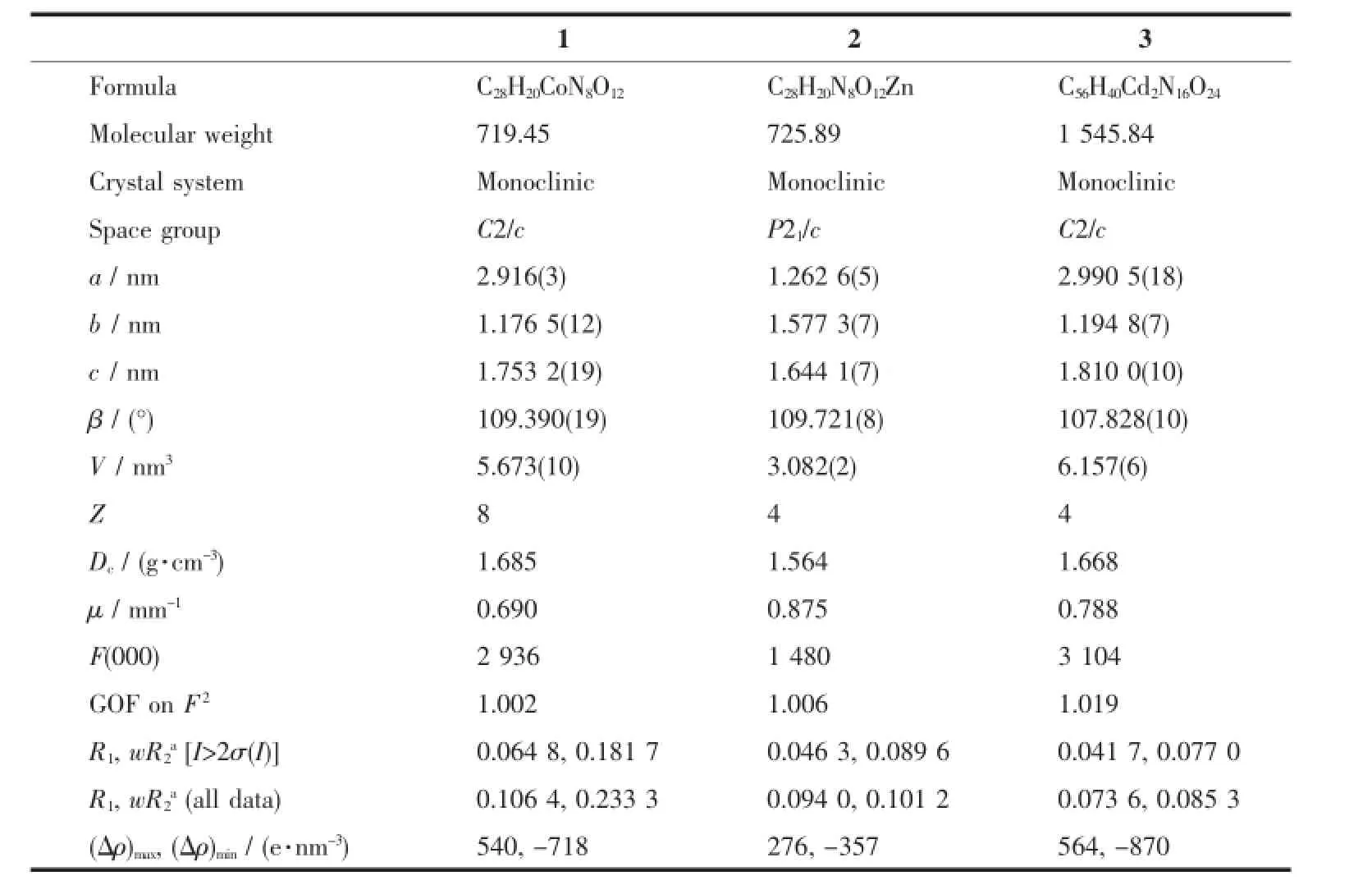
Table 1 Crystal data and structure refinement for 1~3

Table 2 Selected bond lengths(nm)and angles(°)for 1

Table 3 Selected bond lengths(nm)and angles(°)for 2

Table 4 Selected bond lengths(nm)and angles(°)for 3

Fig.1(a)View of the coordination environment of Co(Ⅱ)ion in 1(30%thermal ellipsoids);(b)Dinuclear unit in 1
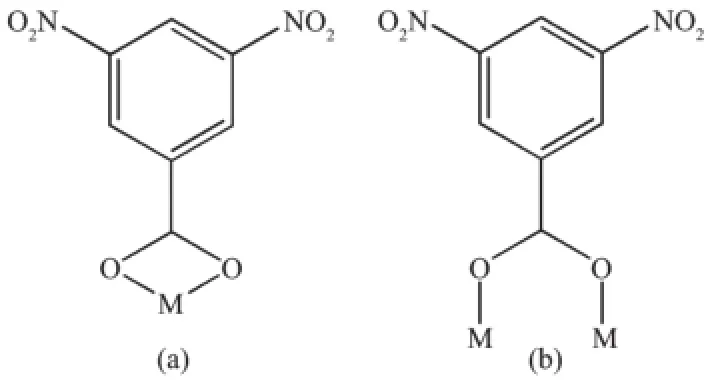
Scheme 1 Coordination modes observed in the ligands: (a)μ-η1∶η1;(b)μ2-η1∶η1
2.1.2 Structuraldescription of 2
Complex 2 crystallizes in the monoclinic space group P21/c.As shown in Fig.2a,the asymmetric unit is made up ofone Zn(Ⅱ)ion,two 3,5-DNB-anions,and one 1,2-bimb molecule.The Zn(Ⅱ)ion is coordinated by two imidazol nitrogen atoms(N3,N6A)from two individual 1,2-bimb molecules and two carboxylate oxygen atoms(O1,O7)from two individual 3,5-DNB-anions to give a{ZnO2N2}tetrahedral geometry.The Zn-O/N bond lengths are in the range of 0.193 3(2)~0.200 4(3)nm.The two 3,5-DNB-anions serve as the same monodentate ligand by using its one carboxylate oxygen atom,which coordinates to an equivalent Zn(Ⅱ)ion.As a result,the{ZnO2N2}tetrahedron are linked by 1,2-bimb molecules to form an infinite chain structure along the c-axis,and the Zn…Zn distance over the 1,2-bimb bridges with the chain is 0.919 2(3) nm.The chains are further extended into a twodimensional(2D)supramolecular structure in the bcplane by theπ…πinteractions between the benzene rings from 3,5-DNB-anions with the centroid-centroid distance of 0.350 0(4)nm[25].
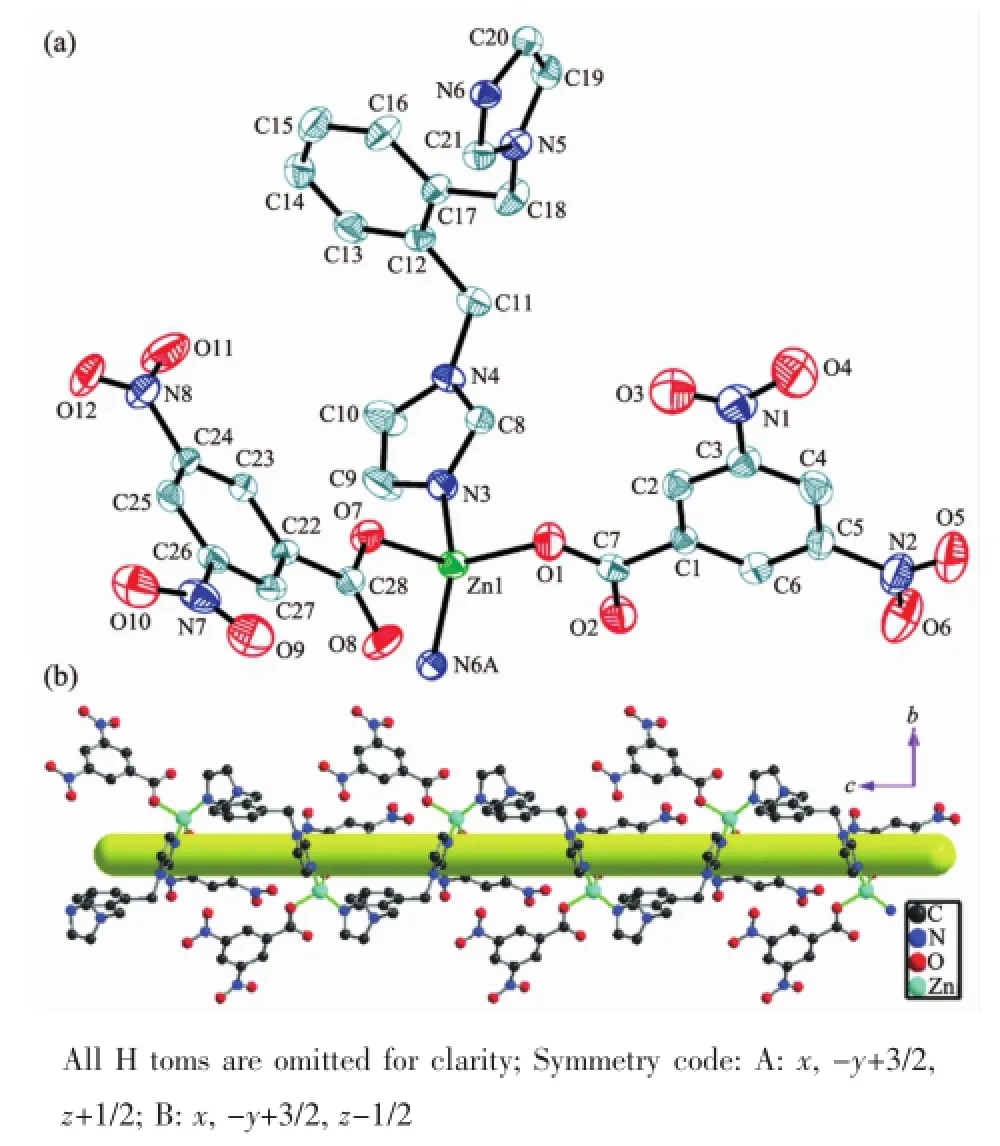
Fig.2(a)View of the coordination environment of Zn(Ⅱ) ion in 2(30%thermal ellipsoids);(b)Infinite chain structure in 2
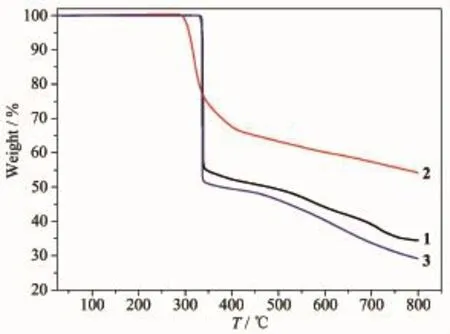
Fig.3 TGA curves of complexes 1~3
Complex 3 is isostructural to 1.A dinuclear unit [Cd2(COO)2]is again observed where the Cd(Ⅱ)ions are coordinated by four carboxylate oxygen atoms and two nitrogen atoms with a distorted octahedral coordination environment.The Cd-O/N distances are in the range of 0.223 3(3)~0.244 9(3)nm.The Cd…Cd distance over the O-C-O bridge in the unit is 0.403 4 nm.
2.2 IR spectra,powder-XRD analyses,and thermogravimetric analyses(TGA)of 1~3
The IR spectra of 1~3 show the typicalstretching mode in the 1 646~1 348 cm-1range(Fig.S1,supporting information).Strong and broad absorption associated with asymmetric(νas)and symmetric(νs)vibrations of the carboxylate groups appearin the 1 646~1 536 cm-1and 1 470~1 348 cm-1ranges,respectively,which indicate the presence of deprotonated carboxylate groups coordinate to the metal ions[26].The experimentaland simulated X-ray diffraction patterns of 1~3 were shown in Fig.S2~S4.Their peaks are in good agreement with each other,indicating phase purities ofthese samples.To examine the thermalstabilities of 1~3,TG analyses were carried out.As shown in Fig.3. Three complexes show relatively high thermal stabilities,which are stable up to ca.300℃.Then,a quick weigh loss are observed and the complexes begin to decompose with the collapse of the structures.
2.3 Fluorescence properties of 2~3
Fluorescence properties of complexes 2 and 3 were studied in the dispersion methanol solution state at room temperature.According to the reported literatures[18,27],the free 3,5-DNBH and 1,2-bimb exhibit weak broad emission bands at 350(λex=275 nm),395 nm(λex=335 nm),respectively.The emission bands of the two free ligands are probably attributable to the π*→n orπ*→πtransition.As shown in Fig.4,the excitation wavelength is 372 nm,and the maximum emission band is 437 nm(λex=372 nm)for 2,and 438 nm(λex=372 nm)for 3,respectively.The emission bands of 2~3 display the main emission peaks exhibiting a red-shift with respect to the free ligands, which are considered to be caused by the ligand-tometal charge transfer(LMCT),which is observed in other Zn(Ⅱ)and Cd(Ⅱ)coordination complexes,primarily in structures containing benzene dervatives[28].
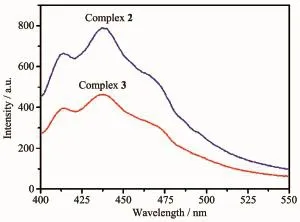
Fig.4 Emission spectra of 2 and 3 dispersed in methanol at room temperature
2.4 Photocatalytic activity of 1
The diffuse-reflectance UV-Vis spectrum of 1 was investigated in the solid state at room temperature.As depicted in Fig.5,complex 1 consists of additional clear absorption bands in the visible regions at434 and 615 nm,which probably originated from the d-d spin-allowed transition of Co(Ⅱ)(d7)ions. The presence of visible light region transitionsencouraged us to investigate applications of 1 in photocatalytic decolorization of organic dyes.Herein, we selected three organic dyes RhB,MB and MO as the target pollutant for degradation experiments to evaluate the photocatalytic performance of 1.As shown in Fig.6,the absorption peaks of RhB solution decrease obviously with increasing reaction time for 1. It can be found that decomposition percentage of RhB increases to about 60%within 140 min.For comparison,the photodegradation process of RhB without 1 has also been carried out under the same conditions.About 5%of the RhB decomposes under visible light irradiation without 1 in 140 min.Similar procedures were performed to check the photocatalytic activities of 1 upon degradation of MB and MO, respectively(Fig.S5,Fig.S6).The decomposition percentage of MB and MO increases to about 13% and 25%within 100 min,respectively.The results indicate that 1 is active for the decomposition of RhB in the presence of visible light irradiation.
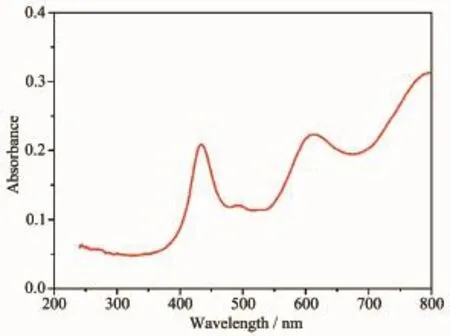
Fig.5 UV-Vis diffuse-reflectance spectrum of 1 with BaSO4as background
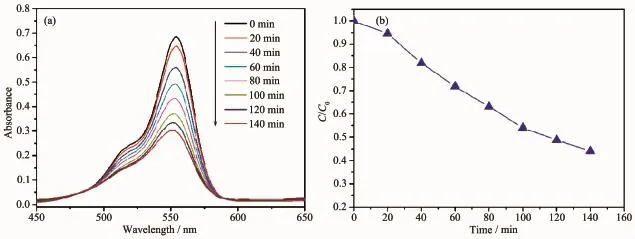
Fig.6(a)Photocatalytic decomposition of RhB solution under visible light in the present of 1;(b)Photodegradation of RhB by 1 monitored as the normalized change in concentration as function of irradiation time
2.5 Magnetic properties of 1
The dc variable-temperature magnetic susceptibility measurement was performed on the polycrystalline sample of 1 at 1 000 Oe in the temperature range of 2~300 K(Fig.7a).At room temperature,the χMT value of 2.85 cm3·K·mol-1of 1 is much higher than the expected spin-only value of 1.875 cm3·K· mol-1for S=3/2 with g=2.0,which can be attributed to the orbital contribution arising from the high-spin octahedral Co(Ⅱ)ions.On cooling down,theχM T value decreases continuously,indicating a dominant antiferromagnetic interaction between the magnetic centers or the spin-orbital coupling of the Co(Ⅱ) ions[29-30].The magnetic susceptibility of 1 obeys the Curie-Weiss law above 50 K with a Curie constant of 3.03 cm3·K·mol-1and Weiss constant ofθ=-22.08 K. As shown in Fig.7b,the magnetization at 70 kOe is 2.18Nβ,in agreement with the saturation value for a Co(Ⅱ)ion with an effective spin S′=1/2 and a large g value of 4.3~4.6.As already described,there is one exchange pathway in propagating the magnetic interactions with the dinuclear[Co2(COO)2]unit through the carboxylate group in 1.The carboxylate group adopts the syn-syn coordination mode,by which significant antiferromagnetic interactions between the Co(Ⅱ)ions are mediated[31-32].
后来,汤甲真收集整理汤匊中生前的部分文稿及许多师生友人怀念他的诗文,汇编成册,并应族人要求,历时5年参与修族谱并捐款。做这些工作,他不取任何报酬,一天到晚无清闲可言而自乐。
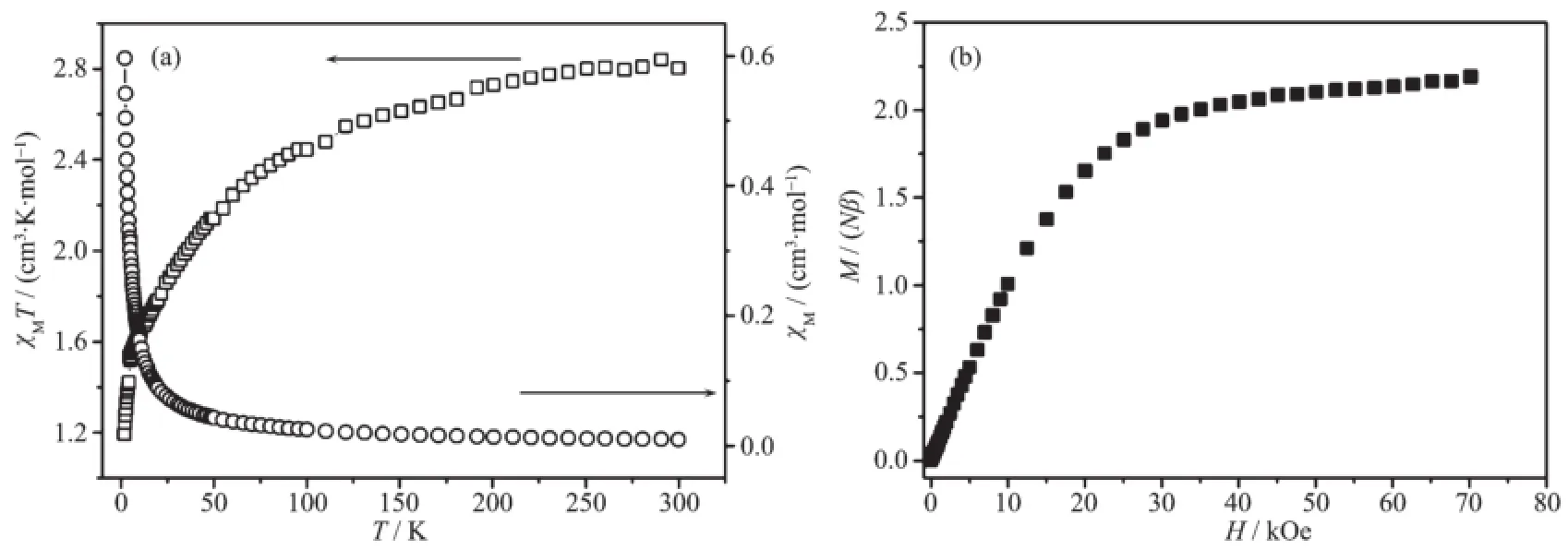
Fig.7(a)χMT andχMvs T plots for 1;(b)Field-dependent magnetization for 1 at 1.8 K
3 Conclusions
In conclusion,three coordination complexes of metal carboxylates containing flexible N-donor coligands were synthesized via the hydrothermal reaction,namely,[M(3,5-DNB)2(1,2-bimb)](M=Co(Ⅱ) (1),Cd(Ⅱ)(3))and[Zn(3,5-DNB)2(1,2-bimb)]n(2).Their structures feature either one-dimensional chains or dinuclear units,which further form the supramolecular structures through weak interactions,depending on the particular co-ligands and metal ions.The results demonstrate that novel transition metal coordination complexes based on the substituted carboxylate may be constructed by suitable flexible co-ligands as auxiliary linkers.Moreover,complex 1 shows good degradation activity under visible light irradiation for the degradation of RhB.Magnetic studies reveal that dominant antiferromagnetic interactions are mediated in 1.
Supporting information is available athttp://www.wjhxxb.cn
[1]Halder R,Matsuda R,Kitagawa S,et al.Angew.Chem.,Int. Ed.,2014,53:11772-11777
[2]Cui Y,Yue Y,Chen B L,et al.Chem.Rev.,2012,112:1126-1162
[3]Wang C,Liu D,Lin W B,etal.J.Am.Chem.Soc.,2013,135: 13222-13234
[4]Wen T,Zhang D X,Zhang J.Inorg.Chem.,2013,52:12-14
[5]Zhao S S,Yang J,Ma J F,et al.Inorg.Chem.,2016,55: 2261-2273
[6]Sarma D,Natarajan S,Drillon M,etal.Inorg.Chem.,2012,51: 4495-4501
[7]Tahmasebi E,Masoomi M Y,Morsali A,et al.Inorg.Chem., 2015,54:425-433
[8]Khan N A,Jun J W,Jeong J H,etal.Chem.Commun.,2011, 47:1306-1308
[9]LüL L,Yang J,Ma J F.Inorg.Chem.,2015,54:1744-1755
[10]Gong Y N,He C T,Lu T B,et al.Chem.Sci.,2016,7:1070-1075
[11]Wang C C,Jing H P,Zhang Y Q,etal.Transition Met.Chem., 2015,40:573-584
[12]Zhang T,Lin W B.Chem.Soc.Rev.,2014,43:5982-5993
[13]Wen L L,Zhao J B,Li D F,et al.Cryst.Growth Des.,2012, 12:1603-1612
[14]Wang C C,Li J R,Guo G S,et al.Energy Environ.Sci., 2014,7:2831-2867
[15]Shen L J,Liang S J,Wu W M,et al.Dalton Trans.,2013, 42:13649-13657
[16]Shen L J,Wu W M,Liang R W,et al.Nanoscale,2013,5: 9374-9382
[17]HU Chun-Yan(胡春燕),XIAO Wei(肖伟),YUAN Hou-Qun (袁厚群),et al.Chinese J.Inorg.Chem.(无机化学学报), 2014,30(2):257-263
[18]NIE Xue(聂雪),CHEN Man-Sheng(陈满生),YU Jiang-Xi (庾江喜),et al.Chinese J.Inorg.Chem.(无机化学学报), 2013,29(12):2704-2708
[19]Jin S W,Huang Y F,Wang D Q,et al.Polyhedron,2013, 60:10-22
[20]Kaur Jassal A,Sharma S,Hundal G,et al.Cryst.Growth Des.,2015,15:79-93
[21]Hoskins B F,Robson R,Slizys D A.J.Am.Chem.Soc., 1997,119:2952-2953
[22]SAINT,Program for Data Extraction and Reduction,Siemens Analytical X-ray Instruments,Madison,WI,1994-1996.
[23]Sheldrick G M.SHELXS-97,Program for Crystal Structure Solution,University of Göttingen,Göttingen,Germany,1997.
[24]Sheldrick G M.SHELXL-97,Program for Crystal Structure Refinement,University of Göttingen,Göttingen,Germany, 1997.
[25]Janiak C.J.Chem.Soc.,Dalton Trans.,2000:3885-3896
[26]Nakamoto K.Infrared and Raman Spectra of Inorganic and Coordination Compounds.6th Ed.New Jersey:Wiley,2009: 64-67
[27]Wang P F,Duan Y,Zheng L M,etal.Dalton Trans.,2010,39: 4559-4565
[28]Allendorf M D,Bauer C A,Houk R J T,et al.Chem.Soc. Rev.,2009,38:1330-1352
[29]Kahn O.Molecular Magnetism.New York:VCH Publishers, 1993:38-39
[30]Carling C L,Translated by WAN Chun-Di(万纯娣),ZANG Yan(臧焰),HU Yong-Zhu(胡永珠),et al.Magnetochemistry (磁化学).Nanjing:Nanjing University Press,1990:33-35
[31]Fabelo O,Pasán J,Ruiz-Pérez C,et al.Inorg.Chem.,2009, 48:6086-6095
[32]Díaz-Gallifa P,Fabelo O,Ruiz-Pérez C.Inorg.Chem.,2014, 53:5674-5683
Three Transition Metal Coordination Complexes Based on the Substituted Benzenecarboxylic Acid and Flexible N-donor Co-ligands: Syntheses,Crystal Structures,and Physical Properties
WU Xiao-Shuo WANG Peng-Fei*LU Peng-Peng XU Si-Yuan
(School of Chemistry and Material Engineering,Chizhou College,Chizhou,Anhui 247000,China)
The hydrothermalreactions of3,5-dinitrobenzoic acid(3,5-DNBH),1,2-bis(imidazol-1-ylmethyl)benzene (1,2-bimb)and transition metal salts result in three new transition metal coordination complexes,namely,[M(3,5-DNB)2(1,2-bimb)](M=Co(Ⅱ)(1),Cd(Ⅱ)(3))and[Zn(3,5-DNB)2(1,2-bimb)]n(2).These complexes were characterized by IR spectra,elemental analyses,single-crystal and powder X-ray diffraction analyses.Complexes 1 and 3 are isostructural and contain a dinuclear[M2(COO)2](M=Co(Ⅱ)(1),Cd(Ⅱ)(3))unit made up of metal ions,3,5-DNB-and 1,2-bimb ligands,which further form the supramolecular structures by the O…πinteractions between the nitro group oxygen atom of 3,5-DNB-anions and the benzene ring of 1,2-bimb molecules.Complex 2 features a 1D chain structure,which further packs to the supramolecular structure by theπ…πinteractions between the benzene rings from the 3,5-DNB-anions.The fluorescence properties of the dispersion methanol solution of complexes 2 and 3 have been investigated at room temperature.Relatively high thermal stabilities are found in the three complexes according to the TGA curves.Photocatalytic studies of 1 indicate good degradation ability over rhodamine B(RhB)under visible light irradiation.Furthermore,the dc magnetic susceptibility measurementof 1 reveals that dominant antiferromagnetic interactions are propagated between the Co(Ⅱ)ions in 1.CCDC: 1476334,1;1476335,2;1476336,3.
transition metal complexes;magnetic property;photocatalytic activity
O614.81+2;O614.24+2;O614.24+1
A
1001-4861(2016)09-1667-09
10.11862/CJIC.2016.191
2016-05-09。收修改稿日期:2016-06-21。
国家自然科学基金(No.21101019)、安徽省高校优秀青年人才支持计划重点项目(No.gxyqZD2016371)和池州学院自然科学研究项目(No.2015ZR001)资助。
*通信联系人。E-mail:njuwangpf@163.com
